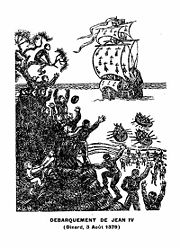
Xavier Haas
Encyclopedia

When he was a child Haas contracted polio in Alsace, which partly disabled him. Shortly afterwards his father was gassed during World War I
World War I
World War I , which was predominantly called the World War or the Great War from its occurrence until 1939, and the First World War or World War I thereafter, was a major war centred in Europe that began on 28 July 1914 and lasted until 11 November 1918...
.
In 1919 he was taken to Sarzeau
Sarzeau
Sarzeau is a commune in the Morbihan department of Brittany in north-western France.It is located on the Rhuys peninsula between the Gulf of Morbihan and the Atlantic Ocean.-History:...
, in Morbihan
Morbihan
Morbihan is a department in Brittany, situated in the northwest of France. It is named after the Morbihan , the enclosed sea that is the principal feature of the coastline.-History:...
Brittany, for a long stay in the hamlet of Lan Hoëdic to recuperate from the effects of polio. While there he met Xavier de Langlais
Xavier de Langlais
Xavier de Langlais was a Breton painter, printmaker and writer. He usually signed his work with the name Langleiz, a Breton language version of his surname.-Early career:...
, who became his lifelong friend. Haas participated in the founding of the Association des paralysés de France (French Association of the Paralyzed) and its newspaper Faire Face (Face Up).
Haas studied at the Ecole des Beaux Arts in Paris. Returning to Brittany, he joined the Breton nationalist art movement Seiz Breur
Seiz Breur
Seiz Breur was an artistic movement founded in 1923 in Brittany. Although it adopted the symbolic name seiz breur, meaning seven brothers in the Breton language, this did not refer to the number of members, but to the title of a folk-story...
in 1936. At the Exposition Internationale de Paris in 1937, he created a "diorama of Brittany" for the Pavilion of Brittany. He also participated in the Breton Christian Art Workshop, founded in 1929 by James Bouillé
James Bouillé
James Bouillé was a French architect based in Brittany.-Biography:Bouillé was born in Guingamp He studied at the École des Beaux-Arts in Paris, until he was mobilized after the outbreak of the First World War in 1914...
and Xavier de Langlais. As part of their work in 1936 he created the frames for the Stations of the Cross
Stations of the Cross
Stations of the Cross refers to the depiction of the final hours of Jesus, and the devotion commemorating the Passion. The tradition as chapel devotion began with St...
of the church Our Lady of La Baule (Loire-Atlantique
Loire-Atlantique
Loire-Atlantique is a department on the west coast of France named after the Loire River and the Atlantic Ocean.-History:...
).
As an illustrator, Haas produced mostly monochrome engravings, but also made multi-block colour prints. He illustrated over 60 stories in the journal "La Bretagne" and a large number of stories and poems in the children's magazine "Ololé". He also illustrated Danio
Jeanne Coroller-Danio
Jeanne Coroller-Danio was a Breton nationalist and writer. She is also known as Jeanne Coroller and Jeanne Chassin du Guerny . Her best known pen-name was Danio, but she published her work under various pseudonyms: J.C...
's history of Brittany.
Along with other members of Seiz Breur, during World War II
World War II
World War II, or the Second World War , was a global conflict lasting from 1939 to 1945, involving most of the world's nations—including all of the great powers—eventually forming two opposing military alliances: the Allies and the Axis...
Haas was associated with the collaborationist Breton National Party
Breton National Party
The Breton National Party was a nationalist party in Brittany that existed from 1931 to 1944. The party was disbanded after the liberation of France in World War II, because of ties to the Nazi party....
. He illustrated their literature during this period.
He had a specially close friendship with the composer Georges Arnoux
Georges Arnoux
Georges Arnoux, was a composer.- Origins :He was the descendant of a family originally from Switzerland. He studied under Vincent d'Indy, at the Schola Cantorum de Paris.- Breton militancy :...
and the Alsatian painter Georges Cornelius, who was based at Ploubazlanec
Ploubazlanec
Ploubazlanec is a commune in the Côtes-d'Armor department in Brittany in northwestern France.Historically its economy relied on fishing. Fishermen in the 19th century and early 20th century went to Iceland aboard sailing ships called goelettes....
in Brittany. Xavier de Langlais said of him, "Beneath his frail appearance, he hid a heart of rare richness. His heart was simple and its affection certain. He was, above all, a friend."

